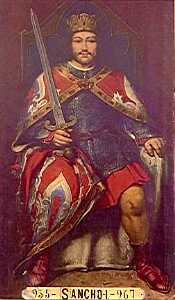
|
In 975 Sancho was defeated by the Moors at San Esteban de Gormaz, and in 981 at Rueda, a dozen kilometers from Tordesillas, the Christians suffered another humiliating defeat. Because he could not defeat Almanzor by arms, Sancho went to Córdoba as an ambassador for his own kingdom, bringing many gifts for the victorious Almanzor, making a pact with him and agreeing to give the Muslim his daughter in marriage. From this union was born Abd al-Rahman Sanchuelo, the heir to the Caliphate of Córdoba.
He was Count of Aragon and King of Navarre from 1004 until his death. Born to García the Tremulous of Pamplona and Jimena Fernández, he ascended the throne in 1004, inheriting Navarre, Aragon, Sobrarbe and Ribagorza. Having gone further than any previous Christian monarchs in uniting the principalities of Spain, his life's work was undone, from a modern point-of-view, when he divided his domains shortly before his death, like any feudal lord, to provide for his sons.
With his nephew, king Alfonso V of Leon and Count García Sánchez of Castile, he led a combined attack against Al-Mansur Ibn Abi Aamir (died 1002; "Almanzor" among the Christians), conquering further territories in the south.
Relation between the three Christian countries soured after the assassination of Count García in 1027. In the ensuing hostilities Sancho occupied first Castile and later on, Leon. This was the height of his rule which extended from the borders of Galicia in the west to the county of Barcelona in the east and he styled himself Rex Hispaniarum, "King of the Spains". Sancho was married to Muña Mayor Sánchez, daughter of count Sancho I of Castile. Besides four legitimate sons he also fathered one by his mistress Sancha de Aybar. Before his death in 1035 Sancho divided his possessions among his sons. Fernando got Castile, García received Navarre and the Basque country and Gonzalo got Sobrarbe y Ribagorza. The illegitimate son Ramiro obtained the county of Aragon, which was elevated to a kingdom.
Son of King García VI Ramírez and Marguerite de l'Aigle, he was the first to use the title "King of Navarre" as the sole designation of his kingdom, dropping Pamplona out of titular use. His reign was full of clashes with Castile and Aragón. He was a monastic founder and many architectural accomplishments date to his reign. He is also responsible for bringing his kingdom into the political orbit of Europe.
He tried to repair his kingdom's borders which had been reduced by the Treaties of Tudellén and Carrión, which he had been forced to sign with Castile and Aragón in his early reign. By the Accord of Soria, Castile was eventually confirmed in its possession of conquered territories. He was hostile to Raymond Berengar IV of Aragón, but Raymond's son Alfonso II divided the lands taken from Murcia with him by treaty in 1163. In 1190, the two neighbours again signed a pact in Borja of mutual protection against Castilian expansion.
He married Sancha of Castile in 1157, the daughter of Alfonso VII. Their children were:
|
Blanche de Navarre (1170s-1229), the youngest daughter of Sancho VI of Navarre and Sancha of Castile, was Countess-consort of Champagne, then Regent of Champagne, and finally also regent of her native kingdom of Navarre.
Her eldest brother Sancho VII of Navarre succeeded their father as king of Navarre. Her brother Ramiro of Navarre was Bishop of Pamplona, and her elder sister Berengaria of Navarre married Richard I of England and Aquitaine, the northern neighbour of their kingdom.
Blanca married Count Theobald III of Champagne, who died young in 1201, leaving her pregnant. When she gave birth to a son, he immediately became count Theobald IV of Champagne (1201-53). Blanca ruled the county as regent until Theobald turned 21 in 1222. The regency was plagued by a number of difficulties. Blanca's brother-in-law, count Henry II had left behind a great deal of debt, which had not been paid off when Theobald III died. Further, their son Theobald's right to the succession of Champagne was challenged by Henry's daughter Philippa and her husband, Erard I of Brienne, Count of Ramerupt and one of the more powerful Champagne nobles. The conflict with the Briennes broke into open warfare in 1215, and was not resolved until after Theobald came of age in 1222. At that time Theobald and Blanca bought out their rights for a substantial monetary payment.
Blanca's brother Sancho VII of Navarre was the last male descendant of the first dynasty of Kings of Navarre, the Pamplona dynasty, and was childless. Sancho went into retirement ("El Encerrado") at some point, when Blanca took administration of the kingdom. She died in 1229, her brother in retirement remaining as King of Navarre and her son Theobald continuing as Count of Champagne.